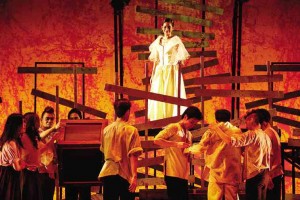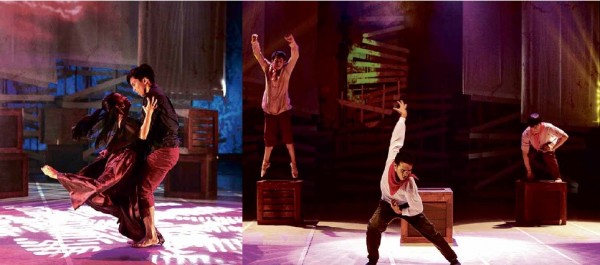
Within a few weeks, the dancers of Ballet Philippines shifted gears from the female-dominated classical “Giselle” to the testosterone-driven dance theater premiere, “Rock Supremo,” making good the wish of founding artistic director Alice Reyes to create a company that can do both classical and modern, as she intimated in her spiel in the 1985 television special “Elvira Manahan and Other Dancers.”
Indeed, both productions merited high ratings.
In “Giselle,” all three ballerinas each had a distinct take on the brokenhearted country lass-turned-phantom. The non-dancing role of Giselle’s mother, exquisitely played by the luminous Shamaine Buencamino, rounded off the production’s charm.
Notable, too, was the corps de ballet’s precision. In Rita Widner’s Queen of the Willis, one could not help but see a young Edna Vida essaying the same role opposite Natalia Makarova years ago. Widner is definitely one to watch.
Perhaps the most heartwarming fact is that the ensemble was not just coached by former BP’s premier danseur Nonoy Froilan and his wife Edna Vida, but alternately guided, too, by the company’s former principal dancers who had danced the lead roles: Cecile Sicangco, Tony Lopez Gonzalez, Brando Miranda, Judell de Guzman, Gina Katigbak.

On premiere night, many other former company members were sighted in the audience. When Froilan, dapper in his dark blazer, walked to take his bow at curtain call, the audience rose to their feet—for here stood the perfect male dance icon, physically handsome, magnanimous in passing on a legacy that refuses to fade despite financial odds.
World premiere
Within a few weeks, on the opposite side of the spectrum was “Rock Supremo,” award-winning playwright Nick Pichay’s dance libretto based on the life of national hero Andres Bonifacio.
Again, creative collaboration was the essence of the success of this piece.
Unlike past attempts at original works, this world premiere discovered the balance between narrative, choreography and music, and this happily contributed to a cohesive output.
The music, for one, was done by 11 outstanding yet diverse rock groups, which provided the variety of moods and textures which translated well into dance. Having different sounds could have worked adversely for the production, but somehow everything was woven together well.
For another, the spoken word was used wisely to establish and drive the narrative along. This idea of dance theater proved to be the perfectly justifiable solution to previously garbled, wordless narratives as in two previous original works: the tale of Mandaluyong (whose title I’ve forgotten), and “Ibarra.”
The collaborative efforts of three choreographers, Alden Lugnasin, Dwight Rodrigazo and Paul Morales, showcased what each did best: Lugnasin’s quirky, inventive moves contrasted with Morales’ flowing love pas de deux.

The masculine energy Rodrigazo is known for in his work sat well in the battle scenes. Except for the sequence where the male dancers alternately jump on each other’s backs, which springs from Agnes Locsin’s “Moriones,” Rodrigazo’s choreography does not fail to excite.
Three highlights
Zeroing in on three separate highlights in Bonifacio’s life centering on his mysterious disappearance and death, librettist Pichay rids himself of having to deal with a strict chronological narrative.
These vignettes leave the choreographers to fully explore in dance the length and breadth of a singular emotion or situation, freeing themselves of having to struggle with pushing the storyline along. The spoken narrative takes care of that, and brilliantly so by the dancers themselves in additional speaking roles: Carissa Adea, Cyril Fallar, Jean Marc Cordero, Richardson Yadao and Morales himself in the special role of narrator.
Sets and costumes by New York-based scenographer John Abul consisted of a wonderfully muted palette in dark tones. (For some reason, productions with local flavor tend to favor a jeepney-inspired color wheel. An exception that comes to mind is the bright but off-colored combinations used by Gino Gonzales in last year’s Christmas presentation of Steps Dance Studio.)
John Batalla’s light design was, as usual, wonderfully apt.
All the leads, Adea and Yadao, and Trofeo and Cordero, as the old and young Bonifacio couple, respectively, were age-appropriately cast.
Notable was Yadao’s portrayal and performance as the Bonifacio of Katipunan fame. His dusky looks and obviously developed musculature were perfectly suitable for a revolutionary hero, as was his energetic dance.
On a more lyrical strain as a young man in love was Cordero, in the tender pas de deux with Trofeo.
Adea’s older, grieving, pained spouse and widow was well-internalized, exhibited in her sharply accented musicality.
“Giselle” and “Rock Supremo,” two productions in succession, do well to serve as a template for Ballet Philippines’ productions to come.
With consistency and attention to detail, these can only lend full support to what already exists: the dancers’ visible continuing drive for excellence in their art.









































